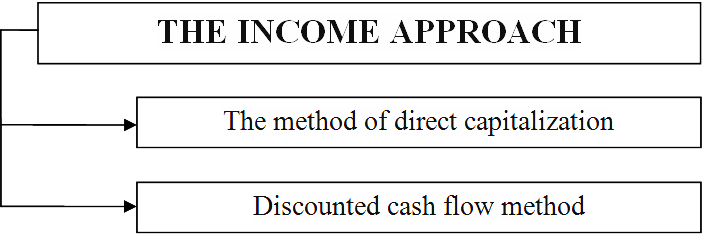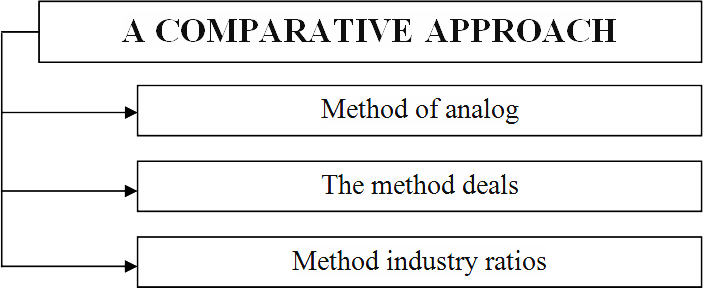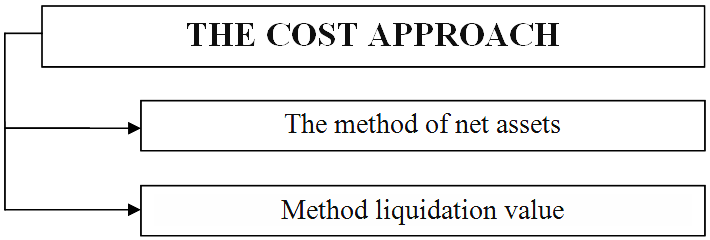Abstract
The content
- Introduction
- 1. Theoretical foundations of business valuation
- 2. Traditional methods of business valuation
- 3. Recommendations for improving evaluations of business value
- Conclusion
- References
Introduction
A business valuation is called a specific, time consuming and complex process, which helps the owner to determine the value of the firm, company or a certain business. This business valuation may be needed in different situations. In any other case. sooner or later. the business valuation will have to spend. This is because the Manager pays to know the market value of his business, as otherwise he will not be able to make decisions that are associated with the sale or acquisition of property rights. We can say that business valuation is the outcome of work conducted by the company throughout its existence. In crisis and unstable external environment cost estimation particularly challenging. Remains critical assessment of the enterprise to attract external funding, and implementation of additional shares, allowing to increase the working capital for carrying out anti-crisis policy.
A business valuation is necessary and useful. To prove it can some examples of what makes this business valuation:
- It is able to make business management more efficient.
- With its help, you can easily find the bases for decision making regarding investments.
- Evaluation helps to start compiling a productive business plan.
- Valuing a business can be smoothly reorganize the company.
- Assessment determines the creditworthiness of the firm.
- It can help to implement tax optimization business.
The problem of the valuation of the company is the subject of research of many foreign and domestic authors, among which we should mention: Damodaran A., F. Evans, Gregory A. , Kohler, T., Gryaznova A. G., Momot T. V., Ruthazer V. M. , Trishina V. N. etc.
The object of study – the process of evaluating the business in the volatile environment.
The subjects of research are methodological basics of valuation of the enterprise.
The aim of this work is the study and justification of the existing methods of valuation of business, the use of assessment methods in crisis and unstable external environment.
1. Theoretical foundations of business valuation.
Valuation of enterprise (business) is a calculation and justification of the value of a company on a particular date. Valuation of a business, like any other object property represents a targeted orderly process of determining the value of the object value in monetary terms taking into account influencing factors in a particular time in a particular market [4].
The term «business valuation» can mean performing certain tasks:
- Initially, the business valuation is to analyze the controlling stake of the company. By performing this task, you can get the most accurate and faithful representation about the price of the entire business.
- Next, the stock is valued. called minority.
- Also evaluated the company's property. Special attention is given to the assets of the business. Such assets may be certain buildings, networks, buildings, land, vehicles, equipment, where an assessment is made of the enterprise. In addition to the property, business valuation subject to financial company routes.
- In rare cases, in addition to the above, subject to the market condition and the condition of the discount. This process is called evaluation of the copier on the market shares of the firm.
Under the cost of business should be understood as expressed in the monetary form and are to date the cumulative flow of all the benefits of the use of his property, who can make his investors. To classify the value of a company (business), approaches and methods used in the process, the cost estimates must be clearly understood that the whole process of evaluation depends on the reasons why, and the goals it pursued. Thus one and the same object on the same date has a different cost depending on the purpose of its assessment, and the cost is determined by various methods.
Valuation of enterprise (business) in all cases is carried out with one ultimate goal – the implementation of the competent management of its activities on the basis of the data obtained in the evaluation process, to allow the company to fulfil its primary economic function is to make a profit.
Business valuation is carried out in stages:
- a contract for the evaluation, including job evaluation;
- collection and analysis of information required for the assessment;
- selecting the best and most efficient use of the object of valuation (determination of market or fair value);
- application of evaluation approaches, including the selection of valuation techniques and the implementation of necessary calculations [2].
2. Traditional methods of business valuation.
To determine the market or other value appraisers use special techniques and methods of calculation, which are called methods of assessment. Each method of evaluation involves a preliminary analysis of a certain information base and the corresponding calculation algorithm. All methods of evaluation allow to determine the value of the business on a specific date and all methods are market, because take into account prevailing market conditions, market expectations of investors, market risks associated with the assessed business, and the supposed "reaction" of the market in transactions of sale and purchase with the assessed object.
Depending on the value drivers, which are the main variables in the algorithms, evaluation methods are divided into methods of profitable, and comparative cost approach. Each approach allows to "catch" certain factors affecting the value. Thus, when assessing the position of the income approach, an emphasis on income as the main factor, which determines the magnitude of value of the object.

Pic. 1 – Existing approaches estimate the cost
(animation: 4 frame, 7 cycles of repetition, 104 Kb)
The income approach to valuation ? methods of valuation of the object of civil turnover, based on the expected income that the object of evaluation can bring to the owner after the date of the assessment, and providing for the conversion (the conversion) of these revenues in the current value at the measurement date. Under the income approach methods are implemented, allowing to convert (to capitalize) future income in real (current, as of the valuation date) value of the object, which is presented in picture 2.

Pic. 2 The Income approach and its methods.
A comparative approach to the evaluation is a set of methods for the determination of property value based on the comparison of this object with objects of similar purpose (objects of comparison or objects–analogues), sold or offered for sale in the past – when known for these objects transaction prices or pricing proposals.
Depending on the purpose, object and circumstances of assessment the comparative approach involves the use of three basic methods (Pic. 3).

Pic. 3 The Comparative approach and its methods.
The cost approach to valuation is a set of methods for determining the value of the object based on the determination of cost of reproduction or replacement of this facility with the addition of opportunity costs arising from changes in time value of money is spent on reimbursement of these costs. The cost approach is based on the principle of substitution. This approach presents two main methods (Pic. 3).
In some cases, it may be inapplicable none of the three approaches to the assessment described above, but can be implemented in a combined cost-profitable or costly-a comparative approach to the evaluation [4].

Pic. 4 The Cost approach and its methods.
3. Recommendations for improving evaluations of business value.
In determining the market value of the company, the appraiser must have a clear understanding of what factors affect the valuation of the business, coniposition affects the result of the calculation.
The external factors include:
- economic;
- social;
- political.
Economic factors:
- Demand. The demand is determined by consumer preferences, which depend on the income generated from the business owner, at what time, what risks it carries, what are the possibilities of control and re-sale of the business.
- Income (profit) of the evaluation object from exploitation and resale.
- Duration of obtaining income. It's one thing if the owner acquires the assets and quickly begins to make a profit from their use, and another thing, if the investment and return of capital are separated by a significant period of time.
- The risk associated with the object.
- One of the most important factors influencing the cost is the degree of control that is received by the new owner.
- The degree of liquidity of the object of evaluation.
- The restrictions imposed by the state or other persons on the object.
- The ratio of supply and demand for similar facilities.
Social factors:
- The availability and extensiveness of infrastructure networks.
- The demographic situation and more.
Political factors:
- The state of legislation in the area of assessment, property tax and so onþþ
- Political and legal situation in the country.
Experience has shown that in modern conditions when determining the value of companies must consider not only the above factors but also to guide the newer tools that take into account the factors that affect the final cost of the business. Today an increasing role in the management given to the assessment of the impact on the cost of quality factors, primarily personnel, information technology and management systems. This impact cannot be assessed in the framework of standard tools, and disregard them in modern conditions can lead to significant loss of efficiency [3].
A leading Russian specialist in the field of business valuation V. M. Ruthazer expressed the following views on the issue of assessment in the volatile environment. In crisis conditions, he believes, is difficult (and often impossible) using the cost approach to business valuation: applied data neproshedshee periods cannot reproduce the current situation the value of assets and liabilities. These data have an inherent delay, they are therefore not representative to represent the changing cost of business.
Caution should be exercised in the use of market (comparative) approach. Apply to the scenario data about companies-analogues are also characterized by a certain delay, they are not quite relevant for establishing the business value of the evaluated company. Limited possibilities of application of cost and market approaches to estimate the value of the business due to the fact that behind their closed premises not in all cases determine the adequate characteristics of the evaluated business.
The comparative approach proceeds on the assumption of the similarity of the data to other companies with harakteristikinaimenovanie business. And here the changes of these data, accelerated in the crisis, often preclude their use for obtaining a measure of the value of the evaluated business.
Appraisers in crisis often resort to using the income approach, or rather, primeneniy model discounted cash flow. In conditions of growing uncertainty of the future economic development, including in relation to the assessed company, the justification of the estimates of business value is moved into the plane of the justification of the prerequisites for the possible occurrence of any of the conditions of formation of net cash flow and risks of generation (discount rate). These assumptions are explicit, not hidden. In this regard, there is variability of estimates of business value depending on the adopted by the appraiser prerequisites. Hence the inevitable presentation of the results of assessments of business value in the form of a range of estimated values.
Of particular importance is the rationale for the different scenarios fixation net cash flows and related risks.
It should be noted that the theory of evaluation activity was unprepared to present reasonable recommendations to address the crisis in the appraisal of the value of the business. This is largely due to the fact that this theory was formed mainly in the steadily growing economy.[5].
Conclusions
In commercial practice there are certain difficulties in the implementation of evaluation activities is inflation, unreliable financial reporting, lack of securities market information and the opacity of the market overall, significant risks when doing business, etc. All this complicates the process of objective assessment. Thus, criteria for the choice of the method of property valuation in a volatile environment should be the object of evaluation and its specific features; the situation in which it is evaluated; purpose of the evaluation; the level of inflation and its forecast for the near future; the possible consequences of a wrong assessment and the risks associated with it.
References
- S. V. Valdice. Business valuation : proc. – 2-e Izd., revised and enlarged extra – M.: Dolby, Univ Prospect, 2004. – 360 p.
- Business valuation: a Textbook/ ed. by A. G. Gryaznova, M. A. Fedotova. – M.: Finance and statistics, 2001. – 512 p.: ill.
- Bukharin N. And., Ozerov, E. S., Papezova S. V., shabrova O. A. Estimation and cost management business: textbook. the manual / Under the General editorship of E. S. Ozerov – SPb: uh-NIT, 2011 – p. 238
- ÀArtemenko, V. G., bellindir M. V. Financial analysis: a tutorial. - M.: "DIS", NGAE and, 1997. - 385 p.
- Economic-mathematical dictionary: Dictionary of modern Economics. – M. :Delo. L. I. Lopatnikov.
